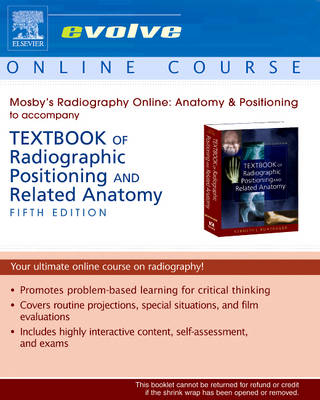
Mosby's Radiography Online: Anatomy and Positioning for Textbook of Radiographic Positioning & Related Anatomy (Access Code)
Seiten
2005
|
6th Revised edition
Mosby (Hersteller)
978-0-323-03613-9 (ISBN)
Mosby (Hersteller)
978-0-323-03613-9 (ISBN)
- Titel erscheint in neuer Auflage
- Artikel merken
Zu diesem Artikel existiert eine Nachauflage
This online companion enhances understanding of anatomy and positioning by providing a well-developed range of media-rich assets, such as narrated animations and interactive activities and exercises. Used in conjunction with the Textbook of Radiographic Positioning & Related Anatomy, 6th Edition, the online companion offers greater learning opportunities than just the text and workbooks offer, while accommodating diverse learning styles and circumstances.
Course management tools provide student and instructor communications options and administrative tools such as real-time chat, class calendar, e-mail connections, bulletin board, digital drop box, discussion boards, instructor syllabus, and grade book. Available on Evolve, Blackboard, and WebCT.
Animations/slide shows with audio narration demonstrate positioning procedures, communicating difficult concepts far better than static illustrations.
Case studies, film evaluations, and a variety of interactive exercises include matching, multiple choice with rationales, labeling, and short answer, to reinforce learning and keep the student involved with the program, thus encouraging more study.
Anatomy review provides an assigned reading from the text followed by a series of self-assessment labeling exercises, challenging the student's knowledge and determining readiness to proceed in the module.
Special situations cover the unique situations frequently encountered in the clinical environment, and include narrated animations, slide shows, and clinical situations requiring a student response. These describe both routine and special projections needed to expertly demonstrate specific types of trauma or pathology.
Film evaluations show positioning and/or technical errors, presented with questions to be answered online by students along with a discussion board related to the radiographs, promoting critical thinking and interactive learning and "linking" the class in online environment.
Learning Links direct students to related sites on the Internet and pose related questions, providing students with additional learning resources.
Capstone module summarizes information presented in the previous modules, providing a series of interactive case scenarios involving multiple regions of the body for the student to assess, evaluate, and solve. An excellent review tool, the Capstone module emphasizes the problem-solving feature of the program.
Pre- and post-testing includes a self-assessment quiz for students to evaluate their own learning needs before taking the exam. The exam is automatically scored and reported to the instructor's gradebook.
Eight new modules are added, so that all areas of the body are covered.
Reading assignments are adjusted to reflect content in the new edition of the core text.
Course management tools provide student and instructor communications options and administrative tools such as real-time chat, class calendar, e-mail connections, bulletin board, digital drop box, discussion boards, instructor syllabus, and grade book. Available on Evolve, Blackboard, and WebCT.
Animations/slide shows with audio narration demonstrate positioning procedures, communicating difficult concepts far better than static illustrations.
Case studies, film evaluations, and a variety of interactive exercises include matching, multiple choice with rationales, labeling, and short answer, to reinforce learning and keep the student involved with the program, thus encouraging more study.
Anatomy review provides an assigned reading from the text followed by a series of self-assessment labeling exercises, challenging the student's knowledge and determining readiness to proceed in the module.
Special situations cover the unique situations frequently encountered in the clinical environment, and include narrated animations, slide shows, and clinical situations requiring a student response. These describe both routine and special projections needed to expertly demonstrate specific types of trauma or pathology.
Film evaluations show positioning and/or technical errors, presented with questions to be answered online by students along with a discussion board related to the radiographs, promoting critical thinking and interactive learning and "linking" the class in online environment.
Learning Links direct students to related sites on the Internet and pose related questions, providing students with additional learning resources.
Capstone module summarizes information presented in the previous modules, providing a series of interactive case scenarios involving multiple regions of the body for the student to assess, evaluate, and solve. An excellent review tool, the Capstone module emphasizes the problem-solving feature of the program.
Pre- and post-testing includes a self-assessment quiz for students to evaluate their own learning needs before taking the exam. The exam is automatically scored and reported to the instructor's gradebook.
Eight new modules are added, so that all areas of the body are covered.
Reading assignments are adjusted to reflect content in the new edition of the core text.
Kenneth L. Bontrager, MA, RT(R) John Lampignano, MEd, RT(R) (CT), Gateway Community College, Phoenix, AZ
1.Positional and Directional Terminology
2.NEW! Image Quality, Digital Technology, and Radiation Protection
3.Chest
4.NEW! Abdomen
5.Upper Limb
6.Proximal Humerus and Shoulder Girdle
7.Lower Limb
8.Proximal Femur and Pelvic Girdle
9.Cervical and Thoracic Spine
10.NEW! Lumbar Spine, Sacrum, and Coccyx
11.NEW! Bony Thorax - Sternum and Ribs
12.Skull and Cranial Bones
13.Facial Bones and Paranasal Sinuses
14.NEW! Upper Gastrointestinal
15.NEW! Lower Gastrointestinal
16.NEW! Gallbladder and Biliary Ducts
17.NEW! Urinary System
18.Capstone
| Erscheint lt. Verlag | 3.8.2005 |
|---|---|
| Verlagsort | St Louis |
| Sprache | englisch |
| Maße | 203 x 254 mm |
| Themenwelt | Medizinische Fachgebiete ► Radiologie / Bildgebende Verfahren ► Nuklearmedizin |
| Medizinische Fachgebiete ► Radiologie / Bildgebende Verfahren ► Radiologie | |
| Medizinische Fachgebiete ► Radiologie / Bildgebende Verfahren ► Sonographie / Echokardiographie | |
| ISBN-10 | 0-323-03613-9 / 0323036139 |
| ISBN-13 | 978-0-323-03613-9 / 9780323036139 |
| Zustand | Neuware |
| Haben Sie eine Frage zum Produkt? |
